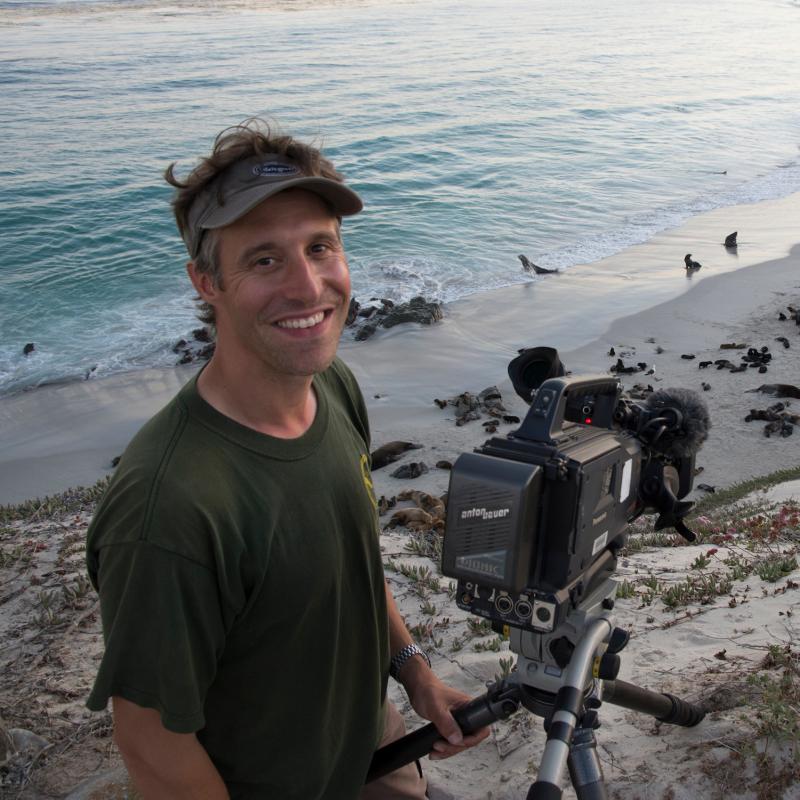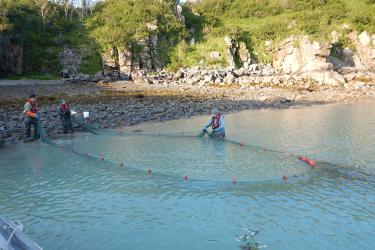Last Stop: Brown Bear Seamount
On September 16th, we arrived at Brown Bear Seamount—our final survey destination and another site where no underwater imagery had been collected before. The 16th and 17th marked days 10 and 11 on the survey. While fatigue began to set in, the crew was fired up to see what Brown Bear had to offer.
When I asked the survey team what their impressions were following the photo transects on Brown Bear Seamount, the general consensus was that there was a lot of coral! And it was interesting seeing more diversity here, like the black corals pictured above.
The depths of Brown Bear were deeper than Cobb, where we saw less coral—though that may be partially due to fishing pressure. It was also right in line with what we saw on Corn and Warwick Seamounts, which both had similar depth profiles. So, in this part of the world, we may be seeing a sweet spot for corals in this 450m to 750m depth range. Of course, these are just preliminary observations. Official conclusions will need to come after extensive analysis of the data. But it’s interesting to notice these patterns.
Another striking observation was the diversity and presence of sponges. In the image above, there are two very different species of glass sponge right next to each other. Below the bugle-shaped sponge that appears to be growing in a spiral pattern, notice the more delicate, folded sponge.
The scientists were fascinated with what they found on every dive. After we return home, the next step is deep analysis of these survey images. These will be coupled with environmental observations to learn more about what else lives at these sites and the conditions that are present.
eDNA: Environmental DNA Sampling
As alluded to above, it’s not just visual data of the seafloor habitat that we collected during this expedition. At every site where the drop-camera was deployed, the team also captured a sample of seawater at the start of the camera transect. When the camera was brought back to the deck of the ship, some team members downloaded the images and replaced the camera battery, while others transferred the water sample to sterile plastic bags.
The water sample is then filtered in the lab with a specific filtering system that targets eDNA, or environmental DNA. eDNA is just as it might sound. It’s DNA that’s floating around in the environment. Why is that useful? Because DNA is unique to animals and plants at the species level. And the individual samples of DNA from the water sample can be sequenced, i.e. mapped, which in turn can be matched up with other known sequences that have been cataloged in libraries over decades. Ultimately, eDNA analysis can suggest what other organisms live at or near that specific site.
This is especially useful for these camera surveys where we are only getting a 15-minute snapshot along a single transect at a site. Who knows, there could be a shark or giant squid that gets spooked by the camera rig, which we never see. This also holds true for many small or microscopic animals that we would never pick up with the camera survey. The eDNA results can give us a much more comprehensive analysis of all the organisms that make up these deep-sea communities. It is another useful tool for management.
Oceanography Data for the Big Picture
The other big science effort taking place on this survey was oceanographic sampling. Scientists from Fisheries and Oceans Canada worked the night shift, making this a 24-hour operation. Once the underwater camera was secured and put to bed for the night, the oceanography team jumped into action. At dusk they were dunking the first bongo nets. The nets get their name from a resemblance to bongo drums. Their purpose is to collect the zooplankton (tiny suspended animals) in the water column at a given site.
The mesh that makes up the bongo nets tapers from the opening to the cod end, where the samples are collected. The apparatus is dropped to the bottom slowly and pulled back up quickly, and the mesh size of the nets and cod-end allow water and very small particles, like phytoplankton, to pass through while isolating the zooplankton. Scientists analyze these samples for distribution and abundance. Here they often found krill (aka whale food!), copepods, larval fish and crabs, and more.
Similar to the eDNA studies, the oceanography team also sampled the water, but for different purposes. They used this CTD rosette with multiple collection bottles. Each bottle shuts at a unique depth and the water samples are analyzed for the oceanographic properties, such as salinity, dissolved oxygen, nutrient concentrations, and more. The rosette was also affixed with instruments that measure conductivity, temperature, and depth, which is where the CTD abbreviation comes from.
These samples will give us a snapshot of conditions observed on this expedition, and feed into long-term data sets to help understand any changes over time, including any signs of climate change. This information is correlated with that from the drop-camera surveys to understand what environmental conditions exist at the time of this survey. This will serve as another data point and baseline for understanding any changes we may observe to these deep-sea coral communities in the future.
More Images from Brown Bear & Thank You!
As we conclude this blog, we hope you enjoyed learning about this Joint Canada-U.S. Deep-Sea Coral Seamount Survey. The international collaborative nature of this survey was a special experience to be a part of, and we owe a huge debt of gratitude to the officers and crew of the Canadian Coast Guard Vessel John P. Tully. Their creativity and problem-solving were exceptional, and we greatly appreciate their dedication to the science mission. There were many overtime hours worked and everyone was nothing but supportive.
If you’re interested in learning more about NOAA’s deep-sea coral and sponge habitat research, check out this blog series from July’s survey in the Gulf of Alaska, the Deep-Sea Coral Habitat page, and, of course, the NOAA Deep-Sea Coral Data Portal.
Finally, we’ll leave you with more of these first images from Brown Bear Seamount. Enjoy!






















